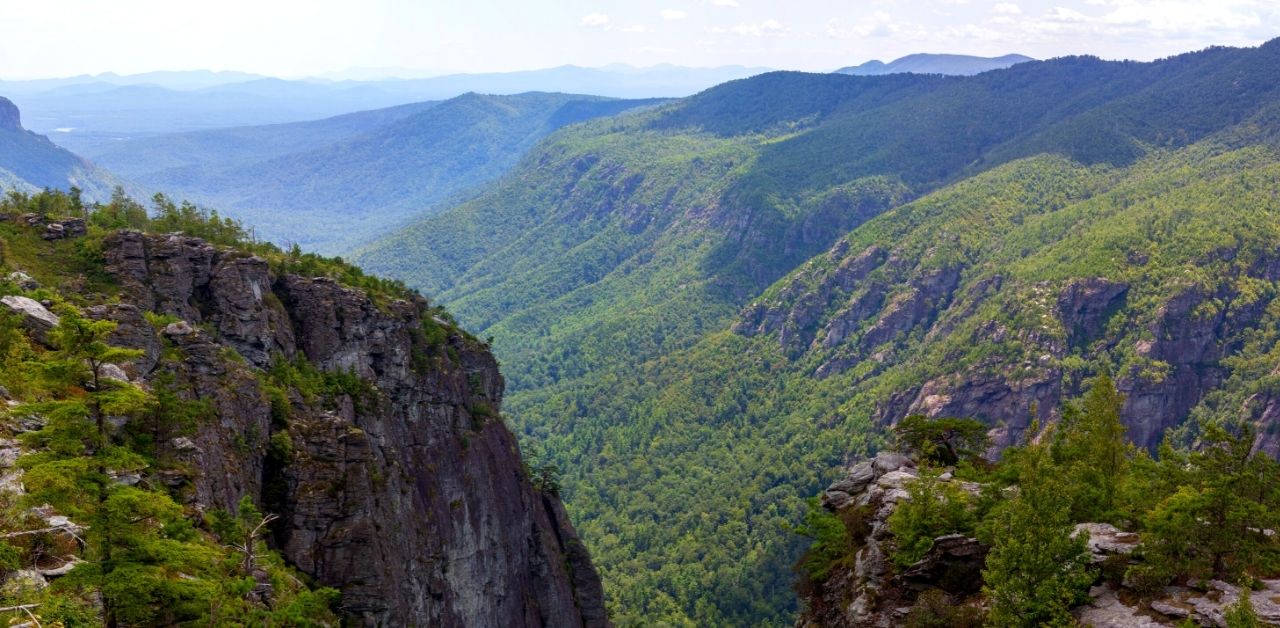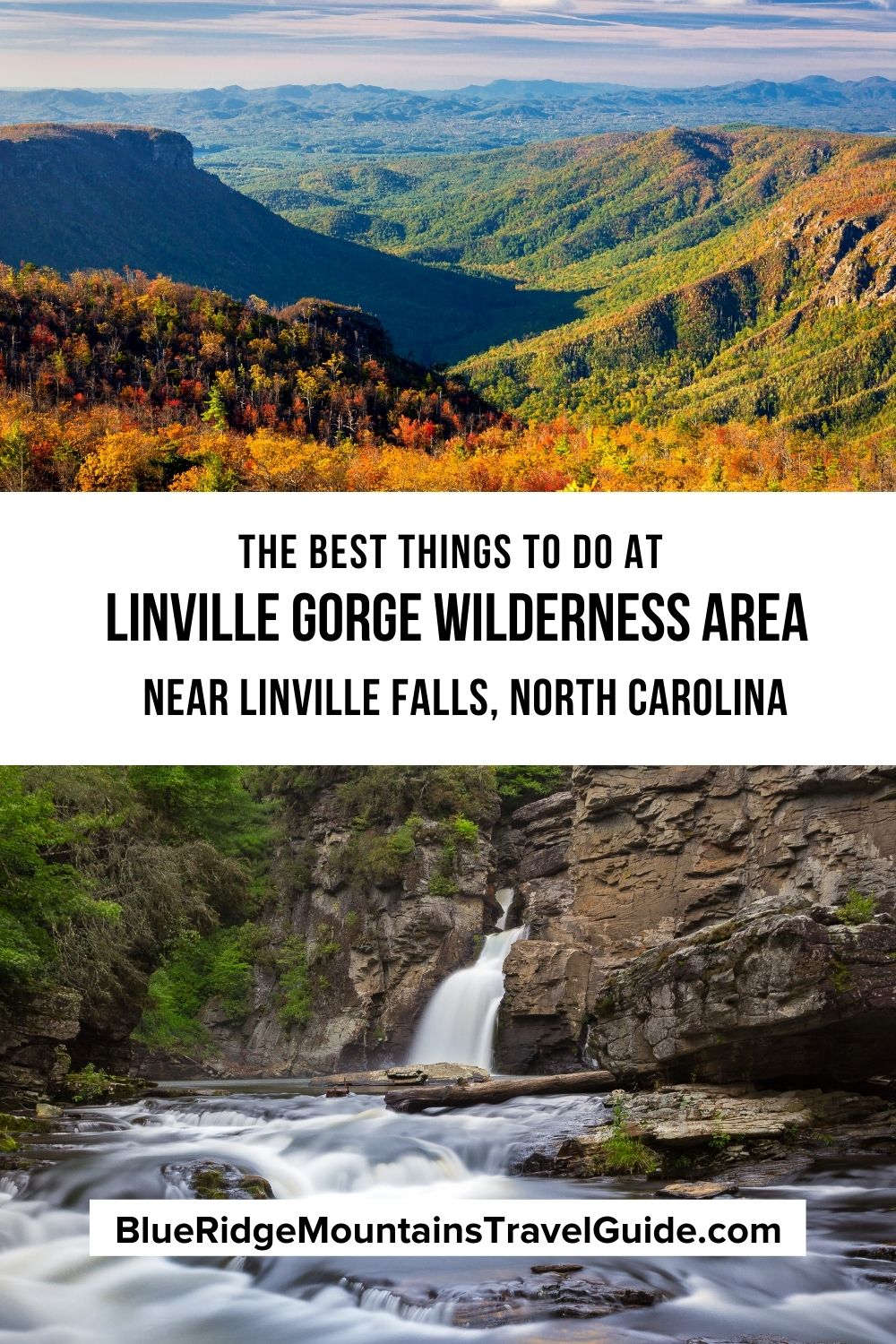Western North Carolina’s Blue Ridge Mountains are renowned for their rugged beauty, and the Linville Gorge Wilderness Area ranks among the most dynamic places to see it.
This 12,000-acre section of Pisgah National Forest is locally referred to as “The Grand Canyon of the East.” It is one of only two wilderness gorges in the Southern US (the other being Bald River Gorge in TN).
Linville Gorge is bounded by the Jonas Ridge to the east and Linville Mountain to the west, and the deep valley 1400 feet below the surrounding cliffs is cut by the Linville River.
The gorge begins below the famous Linville Falls, one of the most beautiful Blue Ridge Parkway waterfalls in North Carolina, and culminates with the Linville River dumping into Lake James.
This expansive natural attraction is popular for hiking, camping, and rock climbing, with opportunities for fishing and occasionally hunting also available.
Famous sites within the Linville Gorge Wilderness include Wiseman’s View, Table Rock Mountain, Hawksbill Mountain, Shortoff Mountain, and The Chimneys. Read on for our in-depth guide on the best things to do in the area.
READ MORE: Top 15 NC State Parks in the North Carolina Mountains

Linville Gorge Wilderness Area Info
ADDRESS: Eastern Rim – FR 210; Western Rim – Old NC-105/Kistler Memorial Highway
PHONE: 828-652-2144 (Pisgah Grandfather District)
LINVILLE GORGE CAMPING RESERVATIONS: 828-652-2144
LINVILLE GORGE WILDERNESS AREA HOURS: N/A
OFFICE HOURS: None
ENTRY FEES/PASSES: None
OFFICIAL WEBSITE: USDA Forest Service
DIRECTIONS FROM THE BLUE RIDGE PARKWAY: Exit left onto US-221 S just south of Milepost 317. In under half a mile, turn left from US-221 onto NC-183.
Once on NC-183, the Western Rim of the park is accessed in about a mile on the right via Kistler Memorial Highway/Old NC-105/NC 1238.
There is a parking area here to visit Linville Falls and its associated North Carolina hiking trails, and further down the road (rough and gravel), you can reach Babel Tower and Wiseman’s View.
To reach the Eastern Rim of Linville Gorge, continue on NC-183 for about 4 miles, turn right onto NC-181 and go 3 miles to Gingercake Road (There is another entrance at 2 miles; pass it).
Less than half a mile on Gingercake Rd., Table Rock Rd. veers up to the left. This takes you to FR 210 and access to Sitting Bear, Hawksbill Mountain, The Chimneys, Table Rock, and more.
READ MORE: The 20 Best Pisgah National Forest Hiking Trails in North Carolina
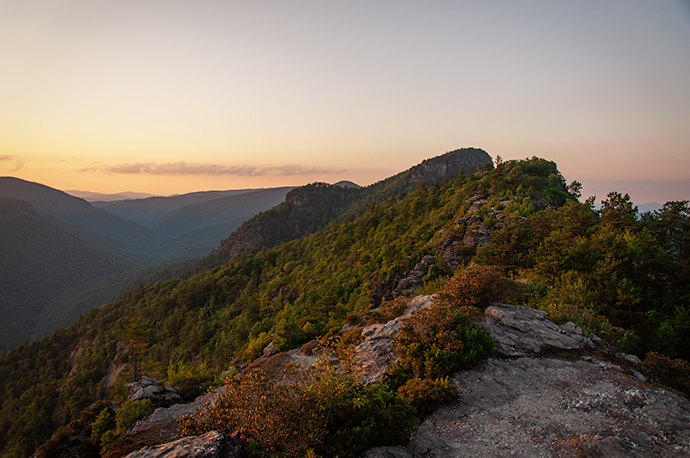
Linville Gorge Wilderness Area History
Geologically, the Linville Gorge has a history that predates history by a billion or so years.
At the north end of the gorge, Linville Falls has exposed rock that dates back a billion years. It was pushed upward in a thrust fault during the formation of the Appalachian Mountain range some 300,000 years ago.
Prior to the area’s colonization, the Cherokee people referred to the Linville River as “the river of many cliffs,” a name you’ll quickly understand with your first look out over the area.
European settlers later named the river after fraternal explorers John and William Linville (whose nephew was the legendary frontiersman Daniel Boone).
The rugged, steep terrain of Linville Gorge made it unwise to settle there in the 1800s and 1900s. When the North Carolina mountains were logged, the difficulty of extracting lumber from the Linville area saved much of the surrounding forest.
Now, Linville Gorge is one of the few places in the Blue Ridge Mountains where virgin old-growth forest remains, and it is the only major valley in North Carolina that doesn’t have a road along the bottom of it.
Formal environmental protection for the Linville Gorge was ultimately solidified in 1952, when John D. Rockefeller purchased it. Then President Lyndon B. Johnson signed the Wilderness Act in 1964, and the Linville Gorge Wilderness Area was one of the first areas to be designated under it.
READ MORE: The 15 Best Things to Do in Cherokee NC & the Qualla Boundary

Things to Do in Linville Gorge Wilderness Area
This is not intended to deter would-be visitors to Linville Gorge, but more to prepare them for the realities of getting there.
The roads along the eastern (FR 210) and western (Old NC 105) rims of Linville Gorge are gravel and notably rough.
Some sections have large potholes and rocks that would make driving smaller cars with low clearance a real challenge. Trucks, SUVs, and cars with 4WD are highly recommended.

Linville Gorge Hikes
The Linville Gorge Wilderness Area has numerous rough-and-tumble hiking trails that lead to some of the best scenic vistas in North Carolina.
Though these trails tend to be on the shorter side (typically a couple of miles or less), most of them are challenging and involve clambering over rocks and roots.
For easier Linville Gorge hikes, it’s best to stay near Linville Falls. From there, visitors can access several different views of the falls via the Plunge Basin Trail, Linville Falls Trail, Linville Falls Overlook Trail, and Erwin’s View Trail.
Otherwise, the sojourn to Wiseman’s View is an easy trail (under 1/2-mile and paved) that is accessible by wheelchair.
The remaining Linville Gorge trails require some confidence with footwork and reasonable fitness. Shorter but rewarding treks include the Babel Tower Trail, Hawksbill Mountain Trail, and Table Rock Summit.
For backpacking Linville Gorge, the Linville River Trail is a 28.6-mile jaunt that climbs up and down along the lower reaches of the valley. Needless to say, it’s a multi-day trip.
The Mountain-to-Sea Trail in Western North Carolina also cuts through Linville Gorge, and includes visits to The Chimneys and Table Rock Summit.
READ MORE: The 15 Best Things to Do in Bryson City NC & Swain County

Linville Gorge Overlooks
Much like visiting the actual Grand Canyon, any trip to the “Grand Canyon of the East” has to be with the mindset of seeing incredible panoramas of some of nature’s best work.
In general, the eastern rim of the canyon is more appreciated for the views it provides. The trails on this side visit mountain summits and meander along the ridgeline a bit more, providing excellent views all along the way.
However, the most revered Linville Gorge overlook is from Wiseman’s View on the western rim. From its lookouts, visitors can spot Table Rock and Hawksbill Mountain, as well as see straight down into the gorge.
Without a doubt, a visit to the Linville Gorge Wilderness Area requires checking out Linville Falls, one of our favorite waterfalls near Asheville NC.
The trails to the falls are accessible from the first parking area on Kistler Memorial Highway.
READ MORE: The 15 Best Blue Ridge Parkway Hikes for NC Day Trips
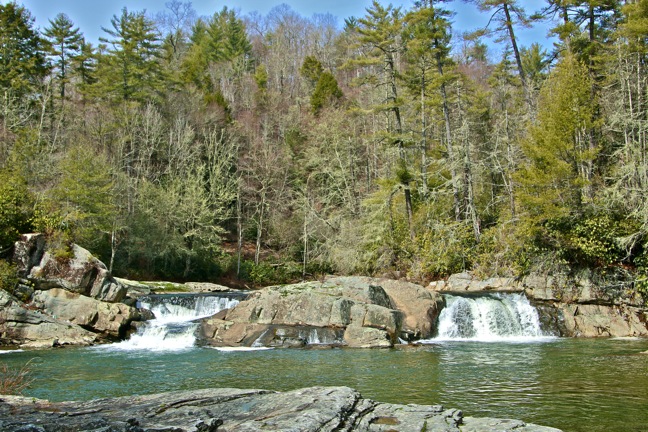
Linville Gorge Camping
For those looking to get out into the wild for a night or two, Linville Gorge camping options include lots of primitive campsites on both the eastern and western rims.
Permits are required for campers, which can be obtained at the Grandfather Ranger District Office in Marion, NC. Walk-in permits are available at the Linville Gorge Information Cabin on Kistler Memorial Highway.
Though you drive to most of the Linville Gorge campsites, note that they are primitive digs with no running water or bathroom facilities (it’s a bury-your-business arrangement).
In keeping with the leave no trace principles, all necessities must be brought in and all trash must be carried back out.
READ MORE: The 10 Best Blue Ridge Parkway Hotels & Cabin Rentals in NC

Linville Gorge Climbing
Linville Gorge is one of the top rock-climbing destinations in the Southeast US, with a wide array of routes available to explore.
Note that all climbing in Linville requires traditional protection While there are some pre-bolted routes to be found, most will require additional gear placements.
Easier climbs include Table Rock and the Amphitheater, while more challenging Linville Gorge Climbing routes can be found on Hawksbill Mountain and Shortoff Mountain.
There are also some excellent bouldering opportunities in the Linville Gorge itself as well.
READ MORE: Things to Do in Little Switzerland NC, Cutest Town on the Blue Ridge Parkway
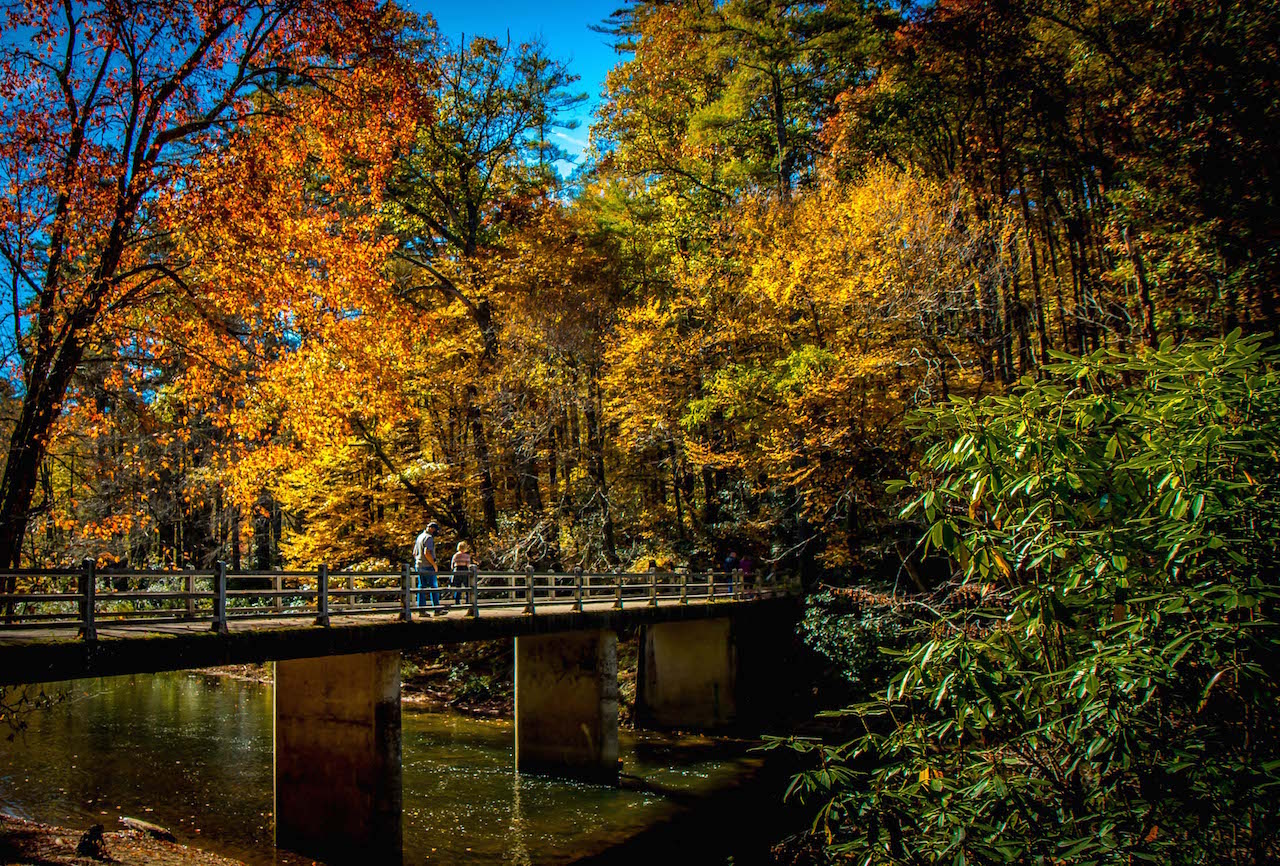
Linville Gorge Fishing & Hunting
The Linville River, which cuts through the bottom of Linville Gorge, offers excellent opportunities for trout fishing.
The river is regularly stocked by NC State hatcheries, and therefore is heavily used. However, accessing spots in the Linville Gorge is a little more challenging, and thus more secluded.
Note that all anglers ages 16 and up are required to have a valid fishing license. Resident and non-resident sport fishing licenses are available via the North Carolina Wildlife Resources Commission.
Hunting, while technically allowed, is rare in Linville Gorge because the terrain is so daunting and there are lots of hikers and campers around. However, it is possible within North Carolina’s authorized hunting seasons.
READ MORE: The 10 Best Lakes in the North Carolina Mountains to Visit
Places to Stay at the Linville Gorge Wilderness Area
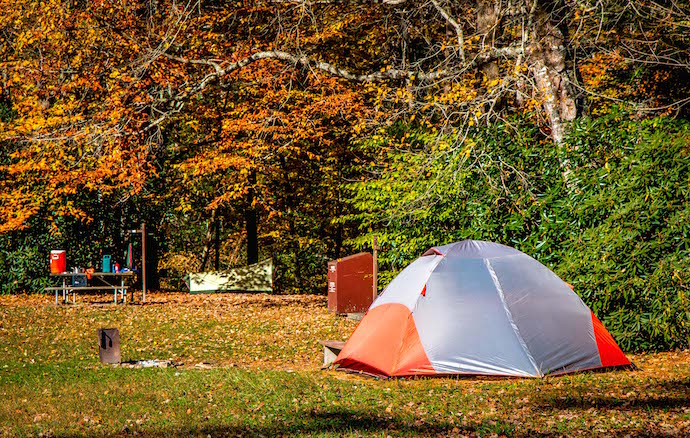
Linville Falls Campground
Primitive camping is available throughout the Linville Gorge Wilderness Area. And though a permit is required to do it, the campsites are free.
However, they are really rustic, with no potable water, bathroom facilities, or bear lockers (and there are plenty of Black Bears in this area!).
But Linville Falls has an official Blue Ridge Parkway campground located right along the Linville River, just north of the Linville Gorge.
The campground has around 60 sites, including RV sites and 25 first-come-first-serve sites that can’t be reserved. There are water spigots and bathroom facilities available, but no showers.
There’s also a privately owned campground, the Linville Falls Campground, RV Park, & Cabins, where campers have access to showers, bathrooms, water/electric hookups, and more. Other bells and whistles include a playground, picnic shelter, dog park, camp store, and laundry room. Private cabins are available for rent here as well.
READ MORE: The 10 Best Things to Do in Burnsville NC

Linville Cabin Rentals
Linville Falls Lodge and Cottages is located less than 3 miles from the Linville Gorge, and it has all the creature comforts you need and then some. The lodge has an interesting history that dates back to the early 1900s.
The 2BR/2 BA Papa Bear’s Cabin (from Cross Creek Cabin Rentals in Linville Falls) is one of our favorite pet-friendly Blue Ridge Mountain cabins, with an expansive back porch, fire pit, and gorgeous forest surroundings.
Upper Creek Cabin is a 1991 sq ft, 3 BR/2 BA, pet-friendly rental located 7 miles miles from Linville Falls.
A cozier 742 sq ft, 2 BR, pet-friendly option is the Heart of Linville Falls rental, which is surrounded by natural beauty and offers serene solitude for relaxation.
READ MORE: 15 Best Things to Do in Boone NC (Blue Ridge Parkway MM 291.8)
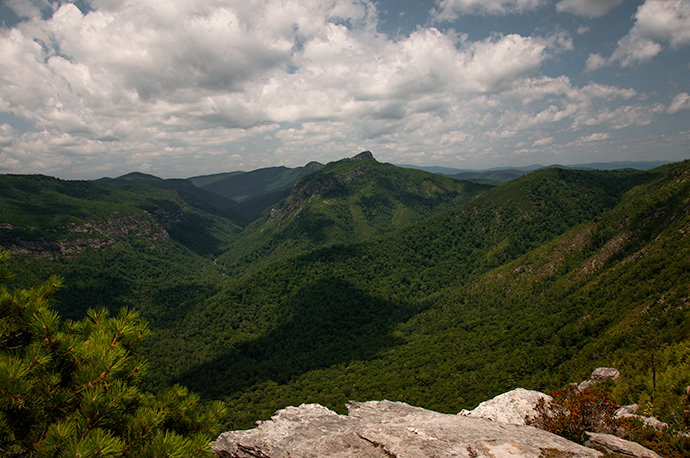
Nearby Towns and Cities
Located about 20 miles north of Linville Gorge, Boone and Blowing Rock are full-tilt vacation destinations with a huge choice of hotels, cafes, museums, supermarkets, and other venues to fulfill whatever whims and flights of fancy a weary traveler might desire.
About 20 miles south of Linville Gorge, the city of Morganton is conveniently located off of I-40, with easy access to Asheville (1 hour), Charlotte (1.25 hours), Greensboro (2 hours), and Winston-Salem (1.5 hours).
Morganton has all the amenities you’d expect from a bigger city, including a designated downtown historical district. —by Jonathon Engels; lead image via Canva

